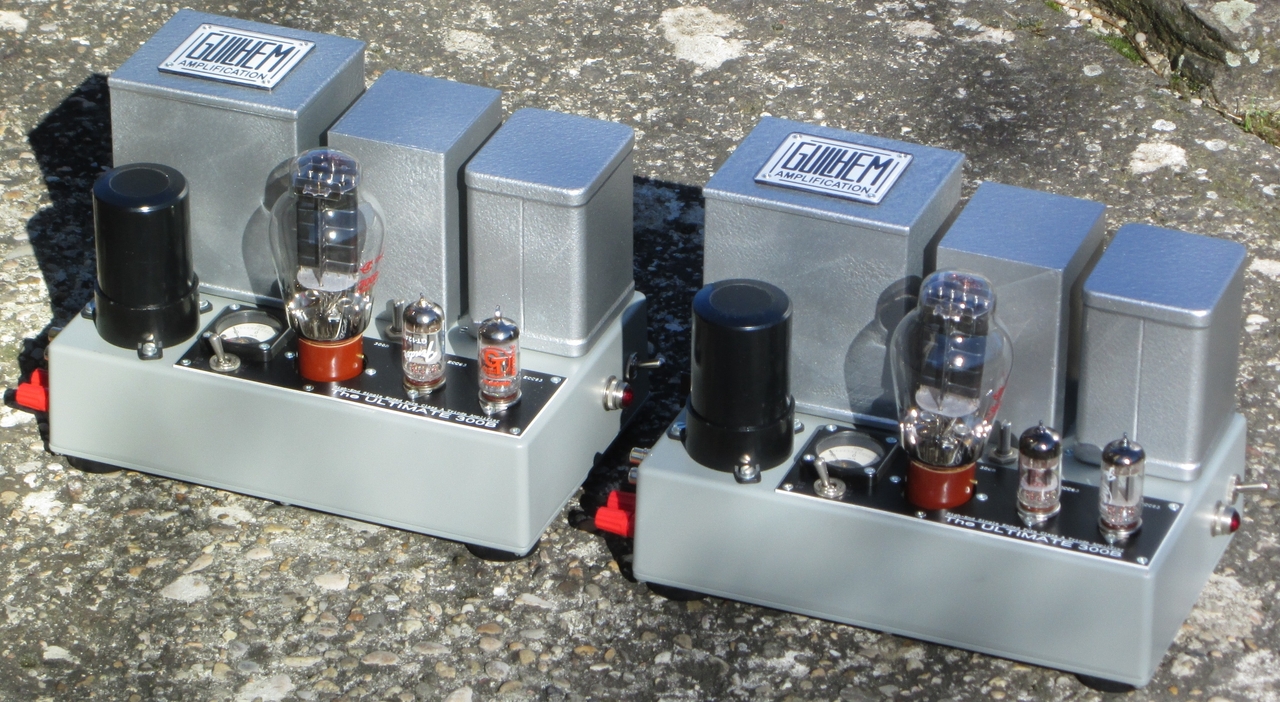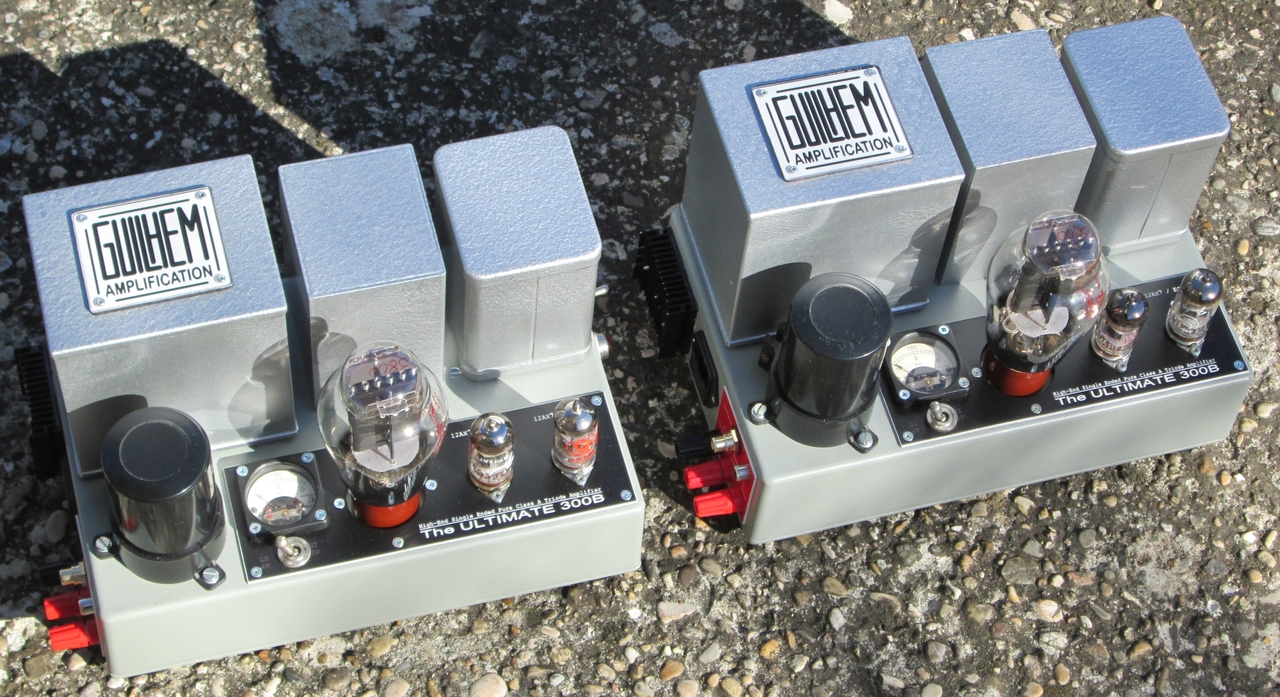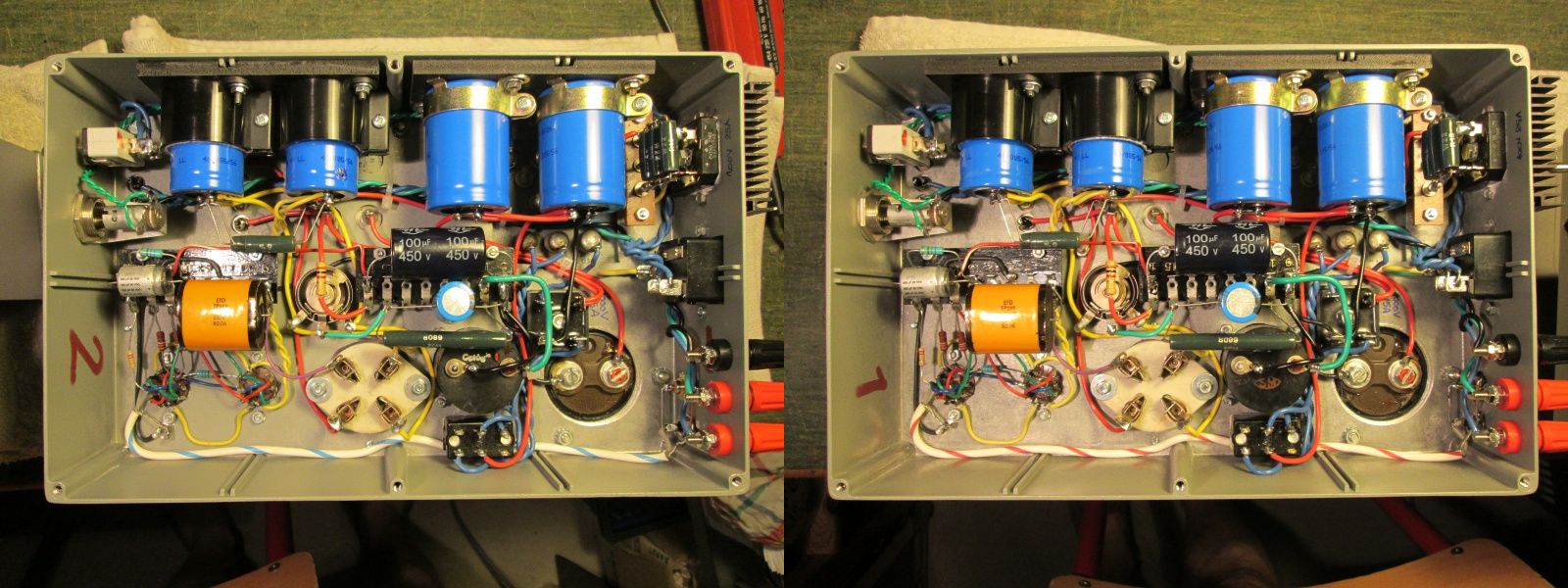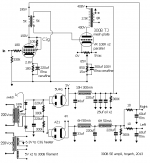Hello People! I'm new to the amp diy building world and I would like to build one with your help! I went for this 300B SET amp and I have most of the components. I really learned a lot from you all from all these threads and posts but now I think I am ready to build one of my own! I have a custom power transformer that I found and it's really close to what I need, I'm missing only one 6,3V output but I bought the Hammond 266L12B for the two 300B tubes(I'll put a picture), I'm thinking of putting maybe two 230V power cables from seperate electrical outlets? But I'm sure there is a better way of doing this. I've made a wooden box and I need some help with that too, What material to use for the top and bottom plates? And I would like to have a PCB for it. I know that the point to point construction is better but I like the clean look of an amp haha. I have all the tubes, output transformers, chokes, Capacitors etc.
DIY 300B Single-Ended-Triode (SET) Hi-Fi Amplifier Project
This is the one I'm trying to make. Have a good day!

DIY 300B Single-Ended-Triode (SET) Hi-Fi Amplifier Project
This is the one I'm trying to make. Have a good day!


An externally hosted image should be here but it was not working when we last tested it.
A stereo amp should have 1 power cord.
A pair of mono-block amps should have 2 power cords.
If the chokes, power transformer, and output transformer are all on the same amp,
do not use a magnetic steel chassis top plate.
Otherwise, Hum Hum Hum.
Before the 6SN7 can warm up, C5 will have Much more than 400V on it.
Do not use a 350V part here.
And, if the 5U4 warms up before the 300B, then C6 and C7 will have More than 500V on them, during power-up.
A pair of mono-block amps should have 2 power cords.
If the chokes, power transformer, and output transformer are all on the same amp,
do not use a magnetic steel chassis top plate.
Otherwise, Hum Hum Hum.
Before the 6SN7 can warm up, C5 will have Much more than 400V on it.
Do not use a 350V part here.
And, if the 5U4 warms up before the 300B, then C6 and C7 will have More than 500V on them, during power-up.
Last edited:
This amp has very high amplification. In fact, it is like a preamp included. It has input volume, but no input switching. And it uses very high voltages. As a novice, I would start with an amp with much lower input sensitivity and lower anode voltages.
Thanks for the reply! I work with electronics almost every day I just don't build amps and I have the parts for this one, that's why I am here on this forum!
A stereo amp should have 1 power cord.
A pair of mono-block amps should have 2 power cords.
If the chokes, power transformer, and output transformer are all on the same amp,
do not use a magnetic steel chassis top plate.
Otherwise, Hum Hum Hum.
Before the 6SN7 can warm up, C5 will have Much more than 400V on it.
Do not use a 350V part here.
And, if the 5U4 warms up before the 300B, then C6 and C7 will have More than 500V on them, during power-up.
This is a stereo amp, one channel shown.
Interesting, so many famous companies used steel sheet chassis with all parts build in one housing and without creating any hum, hum, hum....
Thanks for the reply! I work with electronics almost every day I just don't build amps and I have the parts for this one, that's why I am here on this forum!
If you work with electronics you may have already calculated the voltage amplification of this amp. Its very, very high. Maybe that suits your needs, but I can assure you that it doesn't suit most of todays high output level line signals.
So you will have to give away most of its total amount of amplification.
From the theoretical model of an amp thats nonsense or simply imperfect.
But maybe it suits your needs, just want to tell you.
Most of the majority of tube amps look this way, so so you can use them with any other amp schematic, too.
Have you thought of a simpler 2 stage amplifier? Plenty of schematics to Google. Favourite drivers include D3A and C3G.
the new reference 300B amplifier
the new reference 300B amplifier
Last edited:
I already have 300B, 6SN7 and 5U4GB tubes that I've got and I am looking to make something with them, do you know where can I find schematics with those tubes maybe? And this power transformerr ofcourse.
Last edited:
Not to be misunderstood- I like those three stage SET amps. 300B needs a beefy driver tube and thats the problem with most two stage designs. I like the concept of output tube drives the output tube. Not a whimpy mediocre driver which is limited to drive such a tube.
Look at the circuits of Sakuma San. 300B drives 300B, thats the style I mean.
I owned the original amp- a Sun Audio 300B from which this schematic seems to be a copy. But some parts values had been altered. And thats the problem with those amateur gear and their schematics on the free internet. You will never know if thats a good design or just a mediocre one. Too many faulty amateur schematic for all kinds of tubes out there.
If you know your stuff, the faults can be spotted quickly and badly choosen tube working points, too. But for a novice, its not so easy. Those without expertise must believe anything. Not my style, thats why I build my own designs after studying for years and years.
You can, for example, just remove the first bypass cap and voila- less gain will be the result. But a little less dynamic, too. One death you have to die in any case. So choose your poison cleverly.
Look at the circuits of Sakuma San. 300B drives 300B, thats the style I mean.
I owned the original amp- a Sun Audio 300B from which this schematic seems to be a copy. But some parts values had been altered. And thats the problem with those amateur gear and their schematics on the free internet. You will never know if thats a good design or just a mediocre one. Too many faulty amateur schematic for all kinds of tubes out there.
If you know your stuff, the faults can be spotted quickly and badly choosen tube working points, too. But for a novice, its not so easy. Those without expertise must believe anything. Not my style, thats why I build my own designs after studying for years and years.
You can, for example, just remove the first bypass cap and voila- less gain will be the result. But a little less dynamic, too. One death you have to die in any case. So choose your poison cleverly.
Last edited:
Are you completely set on using a 6SN7 for the driver?
If you are building monoblocks, then you'd have to use both triodes in the 6SN7 package on that one amp. If thr first stage 6SN7 triode has an unbypassed cathode resistor (to reduce its gain) it would have gain of about 12X. Then the second 6SN7 triode would be bypassed to reduce output impedance and would have gain of about 18X. 12*18 = 216X gain (47dB) which is a lot of gain. The grid bias of the 300B might be about -80V, so 80/216 = 370mV peak to full power (approximately). Since most DACs put out 2.8V peak at 0dBFS, that would overdrive the amp by a long shot. So, as you can see, you'd have a lot more gain than you need. You'd be burning most of the signal away in your volume control. Seems a waste.
If you're building a single stereo amp, then you could use one triode per channel from a single 6SN7. That could be your first stage (voltage amplifier). You could use the single 6SN7 triode with its cathode resistor unbypassed, to reduce the gain to about 12X.
The second stage/driver tube could then be chosen for less gain and low output impedance. You could use a triode wired 6V6 for a gain of about 8 or so. Or you could use a triode-wired EL86 for slightly lower gain.
12*8 = 96X gain.
300B grid bias of about -80V:
80/96 = 0.833V
Now it would take about 833mV peak input signal to drive the amp to full power.
That wouldn't be so bad. You still would not need a preamp, so you might want to make it a 'stereo integrated amp' with selector switch and volume control on the front panel of the amp.
D3a in triode has a gain of about 70 (I think). That's not that much less than the 6SN7 to 6V6-triode idea above.
Something like that...
--
The other way to go about this would be to use both sections of the 6SN7 to drive a 300B, but use some kind of negative feedback to bring the gain down to a more useful level. But I figure since you're using a 300B, you won't want to add any negative feedback. Just thought I'd throw the idea out there...
--
If you are building monoblocks, then you'd have to use both triodes in the 6SN7 package on that one amp. If thr first stage 6SN7 triode has an unbypassed cathode resistor (to reduce its gain) it would have gain of about 12X. Then the second 6SN7 triode would be bypassed to reduce output impedance and would have gain of about 18X. 12*18 = 216X gain (47dB) which is a lot of gain. The grid bias of the 300B might be about -80V, so 80/216 = 370mV peak to full power (approximately). Since most DACs put out 2.8V peak at 0dBFS, that would overdrive the amp by a long shot. So, as you can see, you'd have a lot more gain than you need. You'd be burning most of the signal away in your volume control. Seems a waste.
If you're building a single stereo amp, then you could use one triode per channel from a single 6SN7. That could be your first stage (voltage amplifier). You could use the single 6SN7 triode with its cathode resistor unbypassed, to reduce the gain to about 12X.
The second stage/driver tube could then be chosen for less gain and low output impedance. You could use a triode wired 6V6 for a gain of about 8 or so. Or you could use a triode-wired EL86 for slightly lower gain.
12*8 = 96X gain.
300B grid bias of about -80V:
80/96 = 0.833V
Now it would take about 833mV peak input signal to drive the amp to full power.
That wouldn't be so bad. You still would not need a preamp, so you might want to make it a 'stereo integrated amp' with selector switch and volume control on the front panel of the amp.
D3a in triode has a gain of about 70 (I think). That's not that much less than the 6SN7 to 6V6-triode idea above.
Something like that...
--
The other way to go about this would be to use both sections of the 6SN7 to drive a 300B, but use some kind of negative feedback to bring the gain down to a more useful level. But I figure since you're using a 300B, you won't want to add any negative feedback. Just thought I'd throw the idea out there...
--
Neg. feedback isn't the hell for a SET amp when done with IQ. WE itself used it a lot because it has many positive effects. It could bring an amp down in sound, but when applied in a constructive way it benefits a lot to the circuit.
Then by all means, use both sections of the 6SN7 to drive the 300B, and apply negative feedback in a constructive way to reduce distortion, increase damping of the loudspeaker, and reduce the overall gain to a usable level.
Of course now the question is, what is the most constructive way to apply negative feedback to this circuit?
--
Of course now the question is, what is the most constructive way to apply negative feedback to this circuit?
--
My Ultimate 300B...



... Heavily denigrated and criticized by ignorant, jealous and ugly idiophiles; improvised tribunes but true copiers... 😀
A+!



... Heavily denigrated and criticized by ignorant, jealous and ugly idiophiles; improvised tribunes but true copiers... 😀
A+!
Last edited:
This is a really nice looking amp. I saw the schematics and placement of parts on paper on your site next to that amp. Can you maybe send me those to take a look? Thaks a lot!
Thanks @Deva009 !
Oh, no ! According to the experts idiophiles members listed below :
daanve, Dimitris AR, mbrennwa, nicoch58, Schmitz77.
My U-300B is indeed the poorest and the worst designed 300B ever... I let you discover all the uglyness, jealousy and ignorance they can be proud of :
The ultimate 300B
Oh, and you will find the schematic too there... 😉 But beware, it's really not worth the visit... 😀
A+!
Oh, no ! According to the experts idiophiles members listed below :
daanve, Dimitris AR, mbrennwa, nicoch58, Schmitz77.
My U-300B is indeed the poorest and the worst designed 300B ever... I let you discover all the uglyness, jealousy and ignorance they can be proud of :
The ultimate 300B
Oh, and you will find the schematic too there... 😉 But beware, it's really not worth the visit... 😀
A+!
Yes! I found it already before but the photos are no longer available ://
Yes. My previous pic hoster has collapsed... 🙁
But have a look to post #25 linked below : the complete schematic is posted there - the kind of simple schematic will all informations that the said above idiophiles are just unable to imagine or even test nor build... 😀
https://www.diyaudio.com/forums/tubes-valves/245297-ultimate-300b-3.html#post6265178
A+!
Last edited:
- Home
- Amplifiers
- Tubes / Valves
- 300B SET
